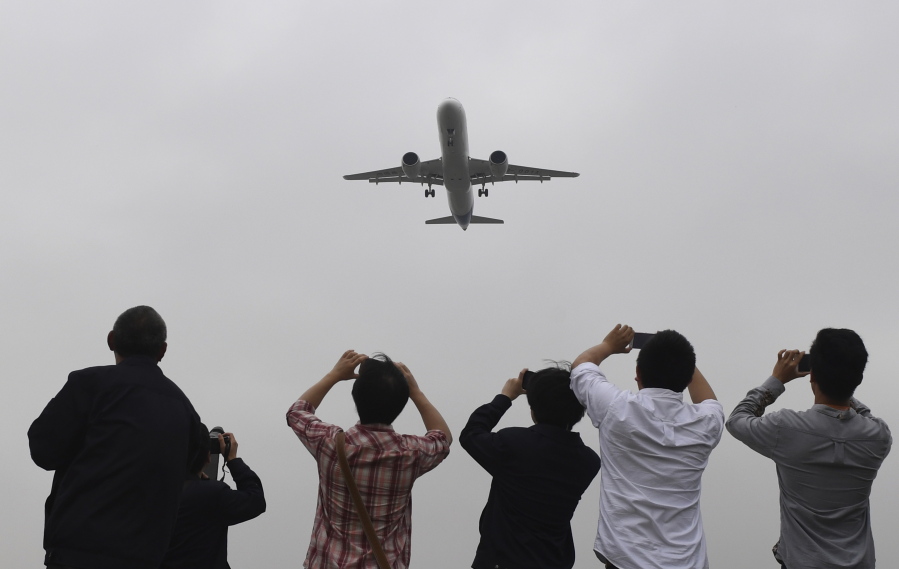The first large airliner designed and built in China successfully completed its maiden flight in Shanghai Friday, a significant milestone in the country’s ambitions to become a power in commercial aviation and to begin to challenge the longstanding duopoly of Airbus and Boeing.
The jet took off from at 11:00 p.m. PST Thursday from Shanghai Pudong International Airport with a five-person crew aboard and landed an hour and 19 minutes later.
In a first for a test flight, a large audience in China and worldwide was able to follow the first flight live on TV and the internet, broadcast from the flight deck of the plane.
The audience could listen to the pilot’s radio communications with the control center while watching a video broadcast that showed on a split screen the view over the pilot’s right shoulder and another outside view of the jet shot through a window of a chase plane.
Both Airbus and Boeing tweeted congratulations to the Commercial Aircraft Corporation of China (COMAC), which built the C919.
Kevin McAllister, chief executive of Boeing Commercial Airplanes, also posted a message on Chinese microblogging website Weibo, which had carried the live feed of the flight, calling the event “an important milestone for Chinese aviation.”
The C919 is roughly the size of the Boeing 737 MAX 8 and the Airbus A320neo.
Yet western experts believe it won’t put much of a dent in the market share of the dominant U.S. and European players.
Launched nine years ago and now running three years late, the C919 jet won’t enter service until 2019 or 2020.
The Airbus neo is already in service and has won more than 5,000 orders. And the Boeing MAX, which is due to enter service later this month with Malaysian carrier Malindo Air, has just over 3,700 orders.
Boeing leaders have said for years that it’s the next generation of Chinese commercial jets after the C919 that will offer real competition, likely around 2030.
Bainbridge Island-based aviation consulting firm Leeham.net said this week that COMAC is targeting a top production rate of no more than seven jets per month well into the next decade.
Boeing plans to churn out 57 of its 737s per month by 2019 and Airbus plans to go to 60 of its A320s per month.
So the C919 “isn’t going to be much of a threat to Airbus or Boeing,” Leeham’s analysts concluded.
Still, the C919 will inevitably sell in China under government fiat, and it may also find buyers among small southeast Asian and African nations dependent on China.
Every one that sells means one less 737 or A320 sale, Leeham said.
Apples to apples
The C919 will seat 180 passengers in a single-class layout, according to a normalized cabin layout used by Leeham.net for apples-to-apples comparisons.
That compares to 177 passengers for the A320neo and 186 passengers for the 737 MAX 8.
The C919 is remarkably similar to the A320. The Chinese even chose to give the flight deck the same Airbus-style side-stick pilot controls rather than the steering column or yoke favored by Boeing.
Since 2008, Airbus has been building A320s in a final assembly plant in Tianjin, China, a joint venture with a Chinese manufacturing consortium that must have helped lay the groundwork for the homegrown airplane.
Leeham analyst Bjorn Fehrm said the C919 is about 4 percent heavier than the two Western jets in the same configuration, which will make it less efficient.
However, the Chinese jet does feature modern avionics and other aircraft systems supplied by major Western suppliers, including GE, Honeywell, United Technologies and Rockwell Collins.
And it has new generation LEAP engines from CFM International, the same family of engines that power the rival MAX and neo jets.
CFM won that engine contract in 2009, and at the time it seemed like the C919 could be the first to market with the new fuel-efficient engines.
But then Airbus and Boeing launched their neo and MAX models to wild sales success while the C919 was delayed, and that potential advantage disappeared.
The development problems that have caused the C919 delays are hardly surprising. Even Boeing, with its long and storied history of airplane making, hit a wall with the 787 Dreamliner.
Yet Richard Aboulafia, industry analyst with the Teal Group, believes that the central planning element and lack of any competition in the Chinese aerospace manufacturing economy inevitably will doom the C919 to mediocrity and unprofitability.
Writing in his monthly newsletter last year, Aboulafia pointed out that “government-managed, funded, and supported jetliners, historically, are not stellar performers.”
“Every single civil aircraft produced by an authoritarian country (or by a socialist economic system) has been a miserable failure on the market,” he wrote.
COMAC reaching the milestone of first flight hasn’t made Aboulafia any more optimistic about the C919.
“They still need to make the plane perform as well as the 737MAX and A320neo. Then they need to establish a massive product support infrastructure and a finance arm. Then they need to produce and sell at prices that allow them to match the two very high volume producers, without losing their shirts,” Aboulafia said Thursday. “The expense and risk has only just begun.”
The Chinese government will likely lose money on the C919. The big question for Airbus and Boeing is how quickly it can follow up with another jet that’s more of a threat.



